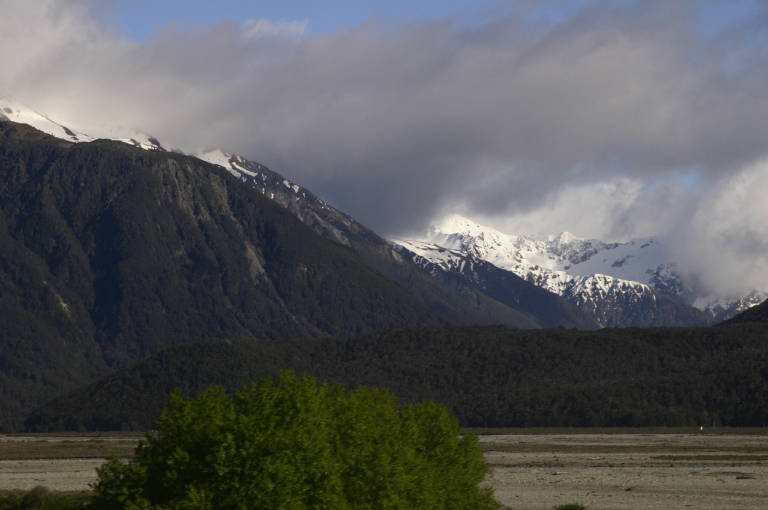
|
| Viewed out the window of the bus after we had gone over Arthur’s Pass |





|
| Viewed out the window of the bus after we had gone over Arthur’s Pass |
We left the Lodge at about 8:30 in the morning, for a long drive through Arthur’s Pass and down to the West Coast, our immediate goal being Hokitika.
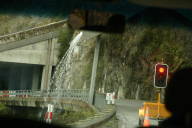
|
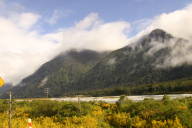
|
In both the lower picture at the left and the one at the top of the page, the yellow-flowered plant is Scotch Broom, a most unfortunate invasive that the Europeans brought with them to New Zealand. It’s not as bad as Gorse (which they also brought), I think, but close. Although Broom is a pest in the Eastern as well as the Western US states, it would seem that it’s not present in any of the localities I’ve lived in, so it was not familiar to me.
There was road construction on the way through Arthur’s Pass, though, so we had to wait a while for traffic coming the other way. As we waited, we admired the sluice carrying melt-water over and away from the roadway, the upper picture to the left (big image, small). Soon we were over the pass and driving along the flood plain of the Taramakau, with the river to our right, as you see in the lower picture to the left (big image, small).
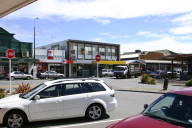
|
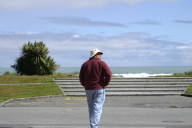
|
We got to the coast, turned left—south— and drove on a bit to Hokitika, a seaside town that looks a lot like many other seaside towns, as you see in the upper picture to the right (big image, small).
When we climbed down out of the bus, Mark and I headed for the beach. A nice broad strand, but with surprisingly few shells thrown up on the sand. I did find a few, reminiscent of our big surf clams of the East Coast, but much smaller. Then, we turned back to the street, and Mark and I walked around the town—there’s not much of it—finding some fairly interesting art galleries and craft shops, especially a glass-blowers’ shop where folks were blowing and shaping some nice vases.
Nicky had told us that we were in the midst of Whitebait season, and that we might have the opportunity to savor some there in Hokitika. Whitebait is the larva of a small brown fish that the New Zealanders call trout, but which is not eaten in the adult stage. The adults, which live in rivers by the coast, spawn in the tidal zone, and after the eggs hatch, nobody knows exactly where in the ocean they live, or how. But then they are maybe 6 cm long (say 2½ inches) and not much thicker than well-cooked linguine, they come back on high tides to return to the fresh water. In immense numbers! So fishermen come to net them up year after year. They’re considered something of a delicacy, and Nicky says that they don’t freeze very well. So if I was ever going to have the experience of eating Whitebait, it might as well be today. We stopped into the Café de Paris, which is apparently the best restaurant in town, and fortunately they were offering Whitebait as a special this noon. I ordered a plate of them, sautéed, and they were very good. A little fishy plain, but with a squeeze of lemon, just right.
As it turned out, all six of us had our lunch at the Café de Paris. From there, we hopped onto the bus, and drove for about an hour and a half to Hari Hari.
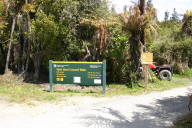
|
||
|
The entrance to the Hari Hari Coastal Walk was perhaps not the most scenic and picturesque, but the walk turned out to be extremely interesting. We saw not only the big Wood Pigeon pictured at the bottom of this page, but of course tree ferns along the way (big image, small) and, farther on, New Zealand Flax (big image, small), about which I’ll have more to say in later paragraphs.
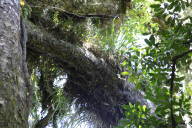
|
| Big image, small |
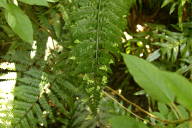
|
| Big image, small |
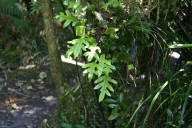
|
| Big image, small |
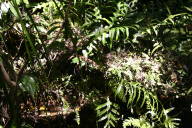
|
| Big image, small |
We were definitely in the rainy part of New Zealand now: the vegetation really made us realize we were walking through temperate rain forest. Just as in the Lakes District of Chile and in Olympic National Park, you saw things growing on things growing on things, like the huge clot of epiphytic plants growing on the branch in the top picture at the left.
The second, third, and fourth pictures to the left show the variety of ferns that we could see. If you look closely at the second picture, you can see baby ferns growing on the mother. Nicky had something interesting to say about this one, as we recall, but neither of us can remember the botanical details. A case of sensory and informational overload, I guess.
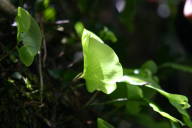
Speaking of ferns, to the right you see a picture of a Kidney Fern (big image, small) a fascinating little plant of a kind that I've never seen before, though Wikipedia assures me that there are some related ones in the Eastern part of North America. The frond, which I never would have called kidney-shaped, is only one cell thick. I tried over and over again to get pictures of other`s, on later days, that were in a reproductive mood. But as with a bunch of other pictures that I wanted to take close up in the dark part of the forest, I couldn't hold the camera still enough to get good results. I did have a monopod with me, mind, but mostly I left it in the room with the raincoat and other things that we brought but had little need for.
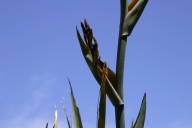
As we got out from under the forest cover and came closer to the open ocean, we saw lots of New Zealand Flax. It's no relation with regular Eurasian flax, of course, which is an angiosperm. Rather, it’s classified in the Hemerocallidaceae,and so not very distantly related to the familiar Common Daylily. But the Maori had no cloth, having had no need for it wherever it was they came from, and when they got to New Zealand, they made plenty of use of the long fibers in the huge leaves of the plant. At the right, I’ve taken a picture of the plant in flower (big image, small), and there is the vertical picture that’s up a few paragraphs, too. If I recall correctly, Nicky remarked at the flowering of the plant: it seems not to do it every summer.
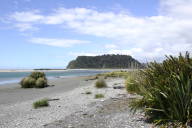
|
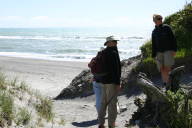
|
| Big image, small | Big image, small |
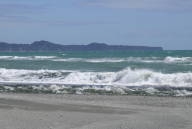
|
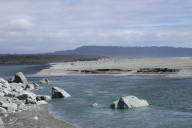
|
| Big image, small | Big image, small |
Once we got to the shore, it was definitely a different scene. I took loads and loads of pictures of shoreline, each one hardly differing at all from the others. The upper left one is nice, I think, ’cause it shows the Flax growing right down to the edge of the beach.
The one on the upper right shows Mark and Nicky, and it was taken right around the time that I suffered two or three minutes of extreme panic, thinking that I had lost the memory card that I had changed out of the camera a half-hour earlier. It contained almost all the pictures I had taken up to that time, and if it really had been gone, there would have been no pictures here from the first to the sixth of the month. But fortunately Mark poked me in the belly, saying, “Is it there?”, and in fact he put his finger right on it, held from falling out by the belt of my pack.
As we walked along the shore, looking at the moderately rough and very cold-looking waters of the Tasman Sea, we soon came to an inlet, and we followed the shore there, to soon return to the forest for our walk back to the trail-head. I tried taking pictures of Kidney Fern and Liverwort—strange the anatomical references involved with these tiny plants—but none of them were at all satisfactory. I did get a nice shot of a very different kind of fern, and it’s below.
We got back into the bus, and arrived at the tiny town of Fox Glacier fairly late, and when we sat down to dinner at the restaurant of our inn, Te Weheka, we were the only people still eating. But it was a nice meal, and in honor of my found (but never really lost) memory card, I bought a bottle of wine for the table.
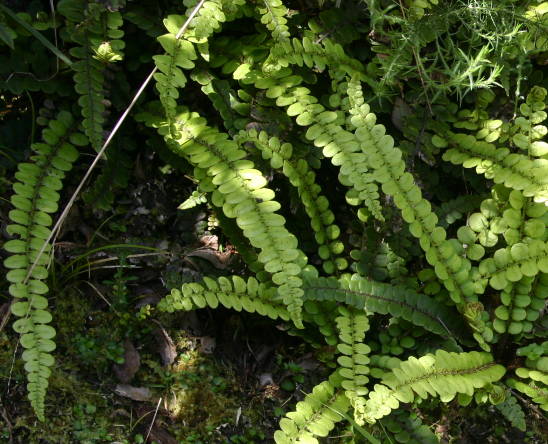
|
Next day’s pictures, previous day’s pictures. Return to the central New Zealand page; to the central travel page; to my home page.
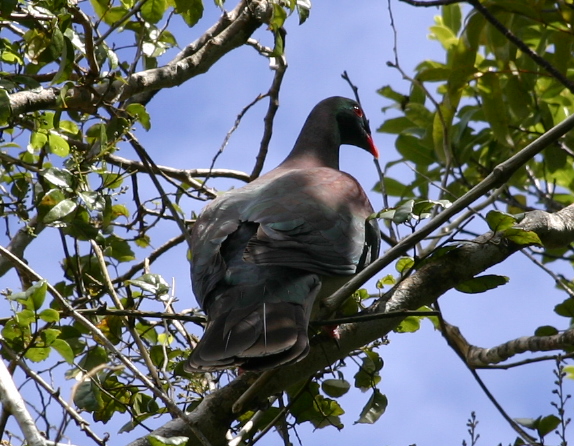
|
| Kereru (“Wood Pigeon”) on our walk at Hari Hari |